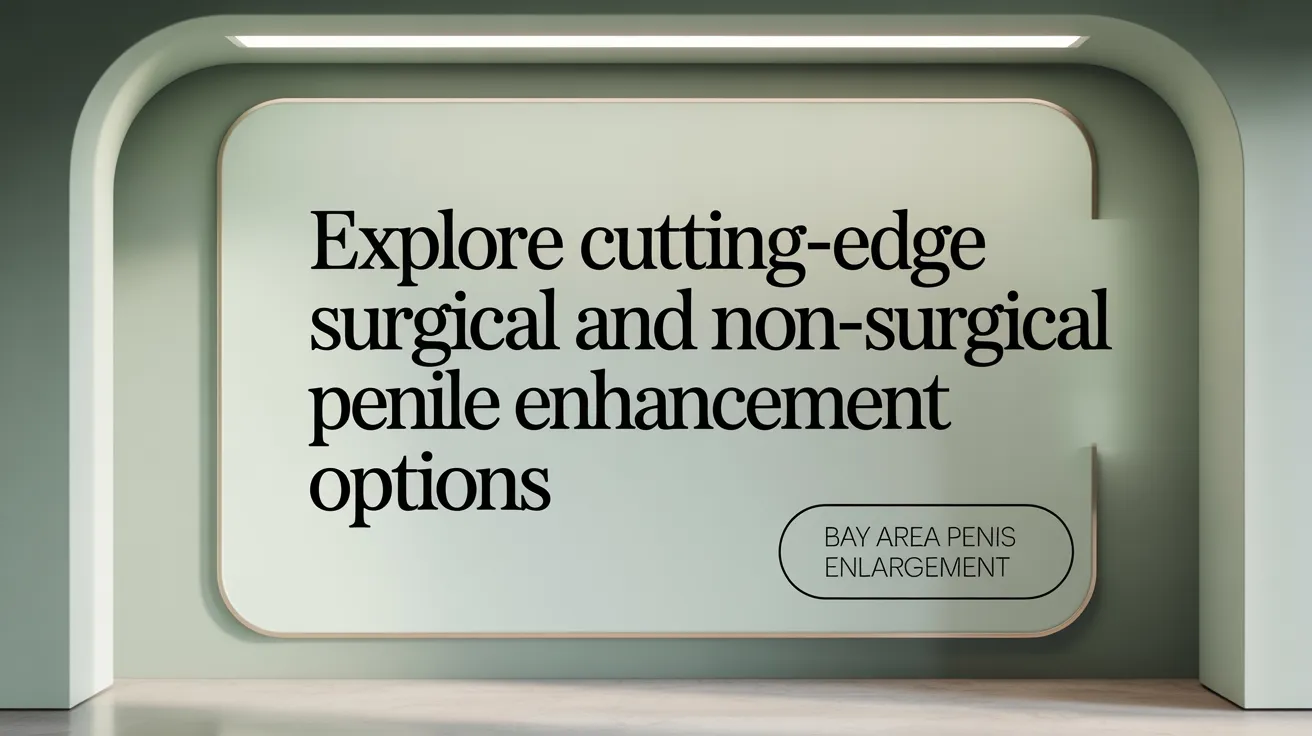Understanding the Complexities of Penile Enlargement and Confidence
The quest to improve penile size and the confidence that accompanies it involves a multi-faceted approach that includes advanced surgical methods, innovative non-surgical techniques, psychological considerations, and cutting-edge research. This article explores the latest evidence-based treatments, addressing physical and mental health dimensions, dispelling common myths, and providing comprehensive guidance on suitability, safety, and outcomes for men seeking enhancement.
Societal, Cultural, and Biological Significance of Penile Size

What is the societal, cultural, and biological significance of penile size?
Penile size has long been a subject of societal and cultural importance. Many societies view a larger penis as a symbol of masculinity, strength, and sexual prowess, which can influence notions of social status and personal confidence. Cultural narratives, media portrayals, and peer comparisons often reinforce these misconceptions, leading men to believe that size correlates directly with sexual success or worth (Reasons men obsess over size).
Scientifically, however, data show that the average erect penile length is approximately 13.1 cm (about 5.1 inches), with the majority of men falling within a normal range (Average erect penis size). This indicates that concerns about size are often exaggerated or based on myths rather than facts. In fact, research suggests that penile size does not significantly impact reproductive ability or overall sexual satisfaction. Women tend to prioritize emotional connection, intimacy, and technique over size, reducing the importance of physical dimensions (Penile length impact on sexual function).
Psychological impacts rooted in societal myths can cause men to develop body image issues, such as penile dysmorphophobia or the so-called Penile dysmorphic disorder symptoms in men
Overview of Advanced Surgical and Non-Surgical Methods for Penile Enhancement

What are the advanced methods for improving penile size, both surgical and non-surgical?
Increasingly sophisticated approaches are available for men seeking penile enhancement, both through surgical and non-surgical means. These methods aim to improve length, girth, or overall aesthetic appearance.
Non-surgical techniques include the use of vacuum erection devices, penile extenders, and injectable fillers such as hyaluronic acid and PMMA microspheres. These approaches are minimally invasive, generally safe, and often involve gradual size increases over time. For example, penile traction devices can provide permanent length gains when used consistently, and dermal fillers offer immediate girth enhancement that lasts for 1-2 years. Topical treatments and regenerative therapies like PRP injections also aim to stimulate tissue growth and blood flow, contributing to size improvements.
Surgical options are more invasive but can produce more significant and lasting changes. Lengthening surgeries involve suspensory ligament release, skin reconstruction via V-Y or Z plasty, and tissue grafting. These procedures can yield length gains of 1.3 to 4 centimeters, especially when combined with techniques like sliding elongation or penile disassembly. Girth enhancement surgeries utilize autologous fat transfer, tissue grafts, biodegradable scaffolds, or subdermal implants such as the FDA-approved Penuma® device, which can increase girth by 39-57% with high patient satisfaction.
In advanced surgical interventions, procedures like total phalloplasty, often used for congenital absence or trauma-related cases, involve complex flap reconstructions with high success rates but higher risks. The newer techniques, such as the tunica expansion procedure (TEP) involving small incisions, enable safer, cosmetic, and effective lengthening.
Overall, selecting the optimal enhancement method involves weighing individual goals, anatomical suitability, and understanding the potential benefits and risks. Psychological assessment prior to intervention is crucial to ensure realistic expectations and overall satisfaction.
| Method | Type | Typical Result | Risks & Limitations |
|---|---|---|---|
| Penile traction devices | Non-surgical | 1-2 cm length increase, permanent | Just requires consistent use, gradual results |
| Injectable fillers (HA, PMMA) | Non-surgical | 1-2 inches girth increase | Temporary, risk of lumps, asymmetry, need for repeat treatments |
| Suspensory ligament release | Surgical | 1.3-2.4 cm lengthening | Surgical risks, visible scar, possible erectile issues |
| Skin reconstruction (V-Y, Z plasty) | Surgical | Increased perceived length | Scarring, deformity, limited to perceived length enhancement |
| Tissue grafting (autologous, xenografts) | Surgical | Substantial girth increase | Graft absorption, infection risk |
| Penile implants (e.g., Penuma®) | Surgical | Girth increase up to 57% | Infection, dissatisfaction, implant complications |
| Total phalloplasty | Complex surgery | Significant length and girth | High risk, complex recovery, usually for congenital cases |
In summary, both new innovations and refined techniques continue to expand the options for penile enhancement, although each has associated benefits and limitations. Careful consultation with qualified specialists ensures the most suitable choice for each patient.
Non-Surgical Penile Enhancement Techniques: Mechanisms and Efficacy
Men seeking to enhance their penile size without the risks of surgery have several established options. These non-surgical methods operate through different mechanisms to provide incremental, often temporary, improvements.
One prevalent approach involves vacuum erection devices and penile traction therapy. Vacuum devices work by creating negative pressure around the penis, drawing blood into the erectile tissue to produce an erection and a slight size increase temporarily. Although these do not produce permanent size gains, regular use can lead to psychological satisfaction and some structural benefits. Penile traction devices, on the other hand, employ gentle stretching over months to stimulate tissue growth gradually. Studies have shown that consistent traction therapy can increase flaccid length by approximately 1.2 to 1.7 centimeters, with some users experiencing lasting results.
Injectable fillers, such as hyaluronic acid (HA), poly L-lactic acid (PLLA), and polymethyl methacrylate (PMMA), are minimally invasive procedures aimed at increasing girth almost instantly. These fillers are injected into the penile shaft to add volume, with HA providing immediate but temporary swelling that lasts about 1 to 2 years, whereas PLLA and PMMA stimulate collagen formation, offering more durable, natural-feeling results. PRP therapy (Platelet-Rich Plasma) (exemplified by systems like RegeneGro) uses the patient’s own blood to produce plasma rich in growth factors. When injected into the penile tissue, PRP promotes tissue regeneration, improves blood flow, and can lead to modest girth and length increases over several months.
Although these techniques are generally safe and associated with minimal risks such as swelling, bruising, or mild discomfort, they lack comprehensive standardization. Their effectiveness varies depending on individual anatomy, technique precision, and the number of sessions. Overall, non-surgical methods are attractive options for men prioritizing safety, quick recovery, and natural-looking results. However, longer-term data and large-scale clinical studies are necessary to establish optimal protocols and confirm their efficacy in permanent size enhancement.
| Technique | Mechanism | Typical Duration of Results | Approximate Size Gain | Common Risks |
|---|---|---|---|---|
| Vacuum Devices | Negative pressure induces blood flow, temporary swelling | Immediate, reversible | Up to a few centimeters short-term | Blue tint, discomfort, minor tissue damage |
| Penile Traction Therapy | Mechanical stretch stimulates tissue growth | Several months, lasting? | 1.2 to 1.7 cm flaccid length | Discomfort, skin irritation |
| Injectable Fillers (HA) | Volume augmentation by gel injection | 1-2 years, temporary | Girth increase up to 1.5 inches | Swelling, asymmetry, possible lumps |
| PRP (RegeneGro) | Growth factors promote tissue regeneration | Gradual over months | Slight girth and length increases | Minor swelling, discomfort |
These non-invasive techniques focus on safety and comfort while offering meaningful improvements for many men. They are most effective as parts of a broader strategy including healthy lifestyle choices, psychological well-being, and realistic expectations. As research advances, their role in penile enhancement continues to expand, providing promising, less invasive alternatives to surgical procedures.
Use of Injectables, Fillers, and Non-Invasive Techniques in Penile Enhancement
Injectables and fillers are popular non-surgical options used to enhance penile size and shape. Materials like hyaluronic acid (HA) are injected into the penile shaft to temporarily increase girth and improve aesthetics. These injections are minimally invasive, typically performed in under 30 minutes by trained healthcare professionals, and do not require anesthesia or lengthy recovery periods. The effects can be seen immediately after the procedure, with results lasting around 1 to 2 years depending on the type of filler used.
The procedure involves injecting small amounts of filler evenly across targeted areas of the penis, providing a natural-looking enhancement that can boost confidence and sexual satisfaction. Many patients appreciate the customization options available, as the amount of filler can be adjusted for desired results.
Beyond fillers, other non-invasive techniques are utilized to promote penile health and size. Shockwave therapy uses acoustic waves to stimulate blood vessel growth and improve blood flow, which may lead to modest size increases over time. Vacuum erection devices temporarily draw blood into the penile tissue, resulting in size enlargement and improved erectile function. Pelvic floor exercises, such as Kegels, can also enhance blood flow and sexual performance, complementing other treatments.
These minimally invasive methods are generally safe, with side effects like minor swelling or bruising often resolving quickly. They offer flexible, less risky alternatives to surgical procedures, making them appealing for individuals looking for subtle, natural enhancements without significant downtime.
Overall, injectables, fillers, and non-invasive treatments provide personalized options for penile enhancement, focusing on improving appearance, confidence, and function with high safety profiles and high patient satisfaction rates.
Surgical Procedures for Penile Enlargement: Techniques, Outcomes, and Risks
What surgical procedures exist for penile enlargement, and what are their techniques, outcomes, and risks?
Surgical options for penile enlargement span a range of techniques aimed at increasing length, girth, or both. One common procedure is ligament release or ligamentolysis, which involves surgically releasing the suspensory ligament of the penis. This releases the tethering effect, making the penis appear longer by approximately 1.3 to 2.4 centimeters. However, this procedure often results in only perceptual lengthening and may sometimes lead to instability or unsatisfactory aesthetic outcomes if not performed cautiously.
Girth enhancements are achieved via various grafting techniques, including autologous fat transfer, dermal grafts, xenografts, and biodegradable scaffolds like PLGA. These procedures generally increase circumference by 2-3 centimeters, with high rates of patient satisfaction when properly executed. Soft tissue fillers such as hyaluronic acid, polymethyl methacrylate (PMMA), or poly-L-lactic acid (PLLA) are also used to temporarily boost girth, lasting from 1 to 2 years, but they carry risks like unevenness, lump formation, and infection.
More complex reconstructive surgeries include total phalloplasty, which involves creating a new penis using tissue flaps from the forearm or other donor sites. These are usually performed for congenital absence or post-trauma reconstruction and have high success rates, approximately 96-100%, but also carry significant risks such as urethral strictures, fistulas, and donor site morbidity.
Sliding elongation techniques involve making multiple tunica albuginea incisions and placing grafts to gain 3-4 centimeters of length. This is a technically demanding procedure with a potential for complications like scar tissue formation, deformity, or erectile function impairment.
Overall, while some procedures can offer modest to substantial size increases, they are associated with notable risks such as scarring, deformity, loss of sensation, erectile dysfunction, and dissatisfaction. These interventions require thorough patient evaluation, realistic expectation management, and expertise from skilled surgeons to mitigate potential adverse outcomes (Risks of penile augmentation surgery, Psychological evaluation before surgery).
| Procedure | Typical Length/Girth Gains | Main Risks | Suitable for |
|---|---|---|---|
| Ligament release | 1.3-2.4 cm perceived length | Deformity, instability | Men seeking length, normal anatomy |
| Fat/graft injections | 2-3 cm circumference | Lump, infection, unevenness | Girth enhancement, aesthetic improvement |
| Total phalloplasty | Variable, up to 10+ cm | Urethral complications, donor site issues | Congenital absence, trauma |
| Sliding elongation | 3-4 cm | Scar, deformity | Men seeking significant length gain |
Patients must consider that these procedures are complex and carry risks, often with disappointing satisfaction rates if expectations are unrealistic. Consulting experienced specialists and conducting comprehensive psychological assessments are essential steps before proceeding with surgical penile enlargement (Patient satisfaction rates in penile surgery, Psychological screening before penile augmentation).
Patient Suitability and Candidate Selection for Penile Enhancement
What factors determine suitability and candidacy for penile enhancement procedures?
Assessing suitability for penile enhancement involves a detailed review of both physical and psychological factors. From a physical standpoint, candidates should be in good health with no significant contraindications such as uncontrolled diabetes, active infections, or severe penile deformities. The penile anatomy, including length, girth, skin elasticity, and vascular health, also influences candidacy. For instance, individuals with very short penile length or poor skin quality might face limited results or higher complication risks.
Psychological evaluation plays a critical role in candidate selection. It helps identify unrealistic expectations and screens for conditions like body dysmorphic disorder (BDD) or penile dysmorphic disorder (PDD). Men with BDD often have distorted perceptions about their penis size and may not benefit from surgery alone, thus requiring mental health counseling before proceeding.
Preoperative considerations extend to lifestyle factors such as smoking status, which significantly impacts healing and complication rates. A thorough review of medical history, including prior penile surgeries or foreign material implants, is necessary. Physical examination should assess skin condition, penile length in both flaccid and erect states, and the presence of any abnormal findings.
In addition, patient expectations must be realistic. Surgeons often utilize surgical simulations or imaging to help patients visualize likely outcomes. Candidates should be willing to adhere to pre- and post-operative instructions, such as abstaining from tobacco and certain medications, to minimize risks.
Other important considerations include the potential need for circumcision, depending on the surgical approach, and previous enhancement attempts that could influence the current procedure planning. Only patients who meet these criteria and demonstrate psychological readiness are deemed suitable for penile augmentation surgery, which aims to improve not just size but overall well-being and confidence.
Evidence-Based Success Rates of Penile Enhancement Treatments
When evaluating the success of penile enhancement procedures overview, it is crucial to consider the scientific data supporting their effectiveness and patient satisfaction. Injectable treatments, such as hyaluronic acid and poly-L-lactic acid, are among the most common non-surgical penile girth enhancement options. These fillers can increase girth by approximately 2.3 to 2.7 centimeters, with hyaluronic acid providing temporary results that last about 18 to 30 months. Such effects are immediate but require repeat procedures to maintain.
Surgical options include autologous fat injections, suspensory ligament release, grafting procedures, and implant placements like Penuma devices. These techniques typically result in length increases of about 1 to 2 centimeters and girth enhancements up to 3.5 centimeters. However, surgical treatments carry risks such as scarring, irregularities, or dissatisfaction with aesthetic outcomes. Long-term data on patient satisfaction are limited; many individuals report disappointing results or complications that diminish perceived benefits.
Overall, the evidence suggests that while both minimally invasive and surgical treatments can produce measurable size gains, the durability and satisfaction are often inconsistent. Many procedures lack large, high-quality studies with standardized outcome measures. Consequently, the medical community emphasizes caution, encouraging thorough patient counseling about realistic expectations. The current data underscores that no method guarantees permanent, significant enlargement, and personal psychological factors often influence perceived success. Therefore, patients should approach these treatments with careful consultation and clear understanding of potential outcomes.
Safety Considerations and Potential Complications of Penile Enhancement

What are the safety considerations and potential complications associated with penile size enhancement methods?
Penile size enhancement procedures, whether surgical or non-surgical, involve various safety considerations and potential risks that must be carefully evaluated. Surgical interventions such as ligamentolysis for lengthening, fat grafting, tissue grafting, and penile implants carry inherent risks including infection, bleeding, tissue necrosis, scarring, deformity, and loss of sensation. More severe complications can occur in rare cases, such as autoamputation or permanent erectile dysfunction if nerves or blood vessels are damaged during surgery (Risks of penile augmentation surgery, Penis enlargement surgery risks).
Non-surgical options, like dermal fillers, pharmacological injections (Penile Injections for Growth), or traction devices, also present specific risks. Fillers, especially those not approved by regulatory agencies like the FDA, can cause inflammation, granuloma formation, hypersensitivity reactions, vascular occlusion, and tissue necrosis (Complications of penile filler injections, Dermal Fillers for Penile Enhancement). Improper technique or unlicensed products significantly increase the likelihood of long-term adverse effects.
The use of unregulated substances such as silicone, paraffin, or other industrial materials during injections can lead to serious complications, including persistent inflammation, migration of filler material, and irreversible tissue damage (Risks and realistic outcomes of penile surgery).
It is essential that these procedures be performed by qualified, experienced healthcare professionals, preferably surgeons trained in male genital surgeries (Qualified urologic surgeons, Expert male genital aesthetic care). Professional assessment helps ensure proper patient selection, accurate procedure execution, and appropriate management of any complications (Patient selection and psychological assessment in penile surgery).
Furthermore, setting realistic expectations through detailed consultation is critical to avoid psychological dissatisfaction, which may lead to additional procedures or mental health issues (Psychological evaluation before surgery, Realistic expectations for augmentation results). Patients should understand the potential for complications and weigh these carefully against the perceived benefits.
In summary, while penile enhancement techniques can offer aesthetic and psychological benefits, they carry considerable risks. Adequate pre-procedure evaluation, expert provider involvement, and adherence to safety standards are crucial to minimizing adverse outcomes and safeguarding patient health (Risks of penis enlargement surgery, Complications of penile enhancement).
Recent Advances and Innovations in Penile Lengthening and Girth Enhancement

What recent advances and innovations have been made in penile lengthening and girth enhancement?
In recent years, the field of penile augmentation surgery has witnessed significant progress driven by technological innovations and refined surgical techniques. Minimally invasive procedures and injectable materials now offer effective and safer options for patients seeking size enhancement.
Injectable fillers such as hyaluronic acid (HA), poly-L-lactic acid (PLA), and polymethyl methacrylate (PMMA) have become popular for penile girth enhancement, providing immediate, natural-looking increases in penile circumference. These fillers are injected in the office setting, with effects lasting from 1 to 2 years, and are associated with high satisfaction rates and minimal side effects (Non-surgical penile girth enhancement).
Innovative surgical approaches have focused on reducing risks and improving outcomes. Techniques like the tunica expansion procedure (TEP), which involves small staggered incisions along the tunica albuginea of the corpora cavernosa, allow for lengthening during prosthesis placement with less scarring and complication risk. These procedures are typically performed through a single scrotal incision, enhancing cosmetic results.
Tissue engineering has opened new avenues for safety and effectiveness. Biodegradable scaffolds such as PLGA and acellular dermal matrices facilitate tissue regeneration, collagen stimulation, and natural enlargement, reducing the likelihood of adverse reactions associated with traditional grafting.
Implantable devices like the Penuma® silicone implant have gained FDA clearance for aesthetic enlargement, offering durable girth and length improvements. High patient satisfaction and low complication profiles are reported, especially when combined with surgical skill and proper patient selection (Penile prosthesis implantation and implant outcomes).
Furthermore, advances in surgical protocols—such as easy-to-perform, less invasive procedures—have lowered complication rates and improved patient outcomes. For example, the use of small, staggered incisions, combined with tissue expansion techniques, has reduced intraoperative and postoperative risks (Sliding elongation and tunica expansion techniques).
Looking forward, the integration of biotechnological innovations promises further improvements. 3D bio-printing enables the creation of customized tissue grafts that match patient-specific anatomy, while artificial intelligence (AI) assists in preoperative planning and personalized treatment strategies.
Overall, these advancements collectively contribute to safer, more effective, and more satisfying penile enhancement options. As research continues, future developments are expected to refine these techniques further, making enlargement procedures increasingly reliable and accessible (Penile augmentation surgery innovations).
Psychological Influences on Penile Size Perception and Confidence

How do psychological factors influence penile size perception, confidence, and body image?
Psychological factors play a crucial role in how men perceive their penile size and overall body image. Many men tend to overestimate what is considered a normal size, often believing their own penis is smaller than average due to societal standards, peer comparisons, or exposure to pornography. These perceptions can lead to persistent feelings of inadequacy, even when their actual measurements fall within typical ranges (2 key reasons why men won’t stop obsessing over size).
Men seeking penile augmentation are frequently driven by concerns about appearance and self-esteem. These motivations may be rooted more in body dysmorphic tendencies than in actual physical deficits. Studies show that a significant portion of men (around 11-14%) seeking these procedures meet criteria for body dysmorphic disorder (BDD) (Psychological characteristics of men pursuing penile augmentation). For these individuals, dissatisfaction with size persists despite objective improvements post-surgery or treatment.
Interestingly, while procedures such as girth enhancement can produce measurable size increases—typically around 2-3 centimeters—many men still perceive their size as below their ideal or what they believe they should have (Men's experiences with penile girth augmentation). This discrepancy highlights the powerful influence of psychological factors on satisfaction and confidence.
Furthermore, research indicates that psychological distress and concerns related to body image tend to stay relatively stable even after physical augmentation (psychological outcomes of penile girth enhancement). This suggests that addressing underlying mental health issues is essential for achieving long-term satisfaction.
Incorporating thorough psychological assessment and counseling into the evaluation process allows healthcare providers to identify unrealistic expectations, manage anxiety, and address body image concerns (Psychological evaluation before surgery). This comprehensive approach can help ensure that patients pursue augmentation for reasons aligned with their true needs and improve the likelihood of lasting improvements in self-esteem and confidence.
Overall, understanding and managing these psychological influences are vital components of responsible patient care and successful outcomes in penile enhancement treatments (Psychological factors in penile size perception).
Guidelines and Mental Health Implications of Penile Size Concerns
What guidelines exist for psychological assessments related to penile size concerns?
Psychological assessment guidelines for men seeking penile size concerns recommend comprehensive screening for body image issues, particularly body dysmorphic disorder (BDD), using validated questionnaires such as the BDD Questionnaire. Clinicians should evaluate the patient's motivations for augmentation, self-esteem, mental health status, and overall body image-related quality of life, often through structured interviews and standardized tools like the Rosenberg Self-Esteem Scale and Body Image Quality of Life Inventory. It is essential to assess for psychiatric comorbidities, including depression, anxiety, and obsessive-compulsive disorder, with appropriate screening measures (e.g., PHQ-9, GAD-7) and clinical interviews. Pre-treatment psychological evaluation aims to identify unrealistic expectations and improve treatment outcomes, ensuring that psychological resilience and stability are established prior to surgical or non-surgical penile augmentation interventions. Overall, guidelines emphasize a multidisciplinary approach involving mental health professionals to optimize patient satisfaction and minimize psychological complications.
What are the mental health implications related to penile size concerns?
Concerns about penile size can have significant mental health implications, including increased anxiety, depression, low self-esteem, and body dysmorphic disorder. Men who perceive their penis as smaller than societal or personal standards often experience diminished body image-related quality of life and feelings of insecurity, which can interfere with sexual confidence and satisfaction. For some individuals, these concerns may reach the level of body dysmorphic disorder, requiring psychological evaluation and support. While not all men experience profound distress, societal pressures and unrealistic expectations can exacerbate psychological struggles related to penile size (Reasons men obsess over size). Addressing these issues typically involves a multidisciplinary approach, combining psychological counseling with medical or surgical options when appropriate (Penile augmentation surgery).
Integrating Physical and Psychological Approaches for Optimal Results
Addressing concerns about penile size and associated confidence involves a delicate blend of advanced medical interventions and thorough psychological assessment. While surgical and non-surgical methods offer promising pathways for physical enhancement, they must be carefully balanced against risks and realistic expectations. Psychological factors critically influence how men perceive outcomes and their overall well-being, underscoring the necessity of mental health screening and support. With ongoing research, technological innovations, and a multidisciplinary approach, men seeking penile augmentation can achieve improvements that extend beyond size—fostering genuine confidence and sexual satisfaction rooted in both body and mind.

